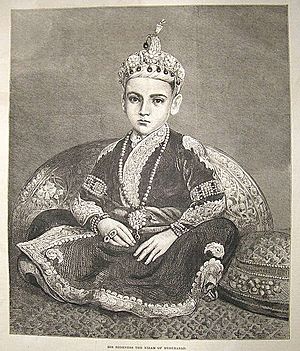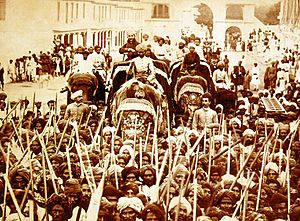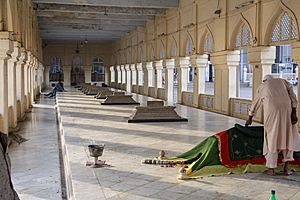Mahboob Ali Khan facts for kids
Quick facts for kids
Mahbub Ali Khan Bahadur
|
|
|---|---|
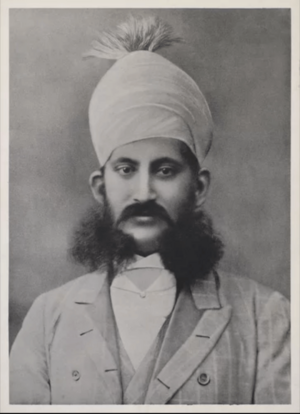 |
|
| 6th Nizam of Hyderabad | |
| Reign | 26 February 1869 – 29 August 1911 |
| Predecessor | Afzal ad-Dawlah, Asaf Jah V |
| Successor | Mir Osman Ali Khan, Asaf Jah VII |
| Born | 17 August 1866 Purani Haveli, Hyderabad, Hyderabad State, British Indian Empire (now in Telangana State, India) |
| Died | 29 August 1911 (aged 45) Falaknuma Palace, Hyderabad, Hyderabad State, British Indian Empire (now in Telangana State, India) |
| Burial | Mecca Masjid, Hyderabad, Hyderabad State, British Indian Empire (now in Telangana State, India) |
| Spouse | Amat uz-Zehra Begum |
| House | Asaf Jahi dynasty |
| Father | Afzal ad-Dawlah, Asaf Jah V |
| Religion | Sunni Islam |
Asaf Jah VI, also known as Sir Mir Mahboob Ali Khan Siddiqi Bayafandi (born August 17, 1866 – died August 29, 1911), was the 6th Nizam of Hyderabad. A Nizam was a ruler of the Hyderabad State, a large kingdom in India. He ruled this state from 1869 to 1911, making many important changes during his time.
Contents
Early Life of Asaf Jah VI
Mahboob Ali Khan was born on August 17, 1866, in Purani Haveli, Hyderabad. This area is now part of Telangana, India. He was the youngest son of the 5th Nizam, Afzal-ud-Daulah. When his father passed away in 1869, Mahboob Ali Khan became the Nizam at just two years old.
Because he was so young, two important people helped him rule. These were Salar Jung I, who was the Prime Minister, and Shams-ul-Umra III. They acted as regents, meaning they ruled on his behalf until he was old enough.
Mahboob Ali Khan was the first Nizam to receive a Western-style education. A special school was set up for him at the Chowmahalla Palace. He learned English from Captain John Clerk, who had also taught the Duke of Edinburgh. He also studied Persian, Arabic, and Urdu. This education helped him understand both Indian and Western cultures.
Mahbub Ali Khan's Reign
Becoming the Ruler
When Mahboob Ali Khan turned sixteen, Salar Jung I started teaching him about how the state was run. Important officials would meet with him to explain their work. On February 5, 1884, he officially became the full ruler at his investiture ceremony. Lord Ripon, the Governor-General of India, was there and gave him a special golden sword. Mahboob Ali Khan took on the grand title His Exalted Highness Asaf Jah, Muzaffar-ul-Mulk, Nawab Mahbub Ali Khan Bahadur, Fateh Jung.
Building a Railway Network
During his rule, the Nizam's Guaranteed State Railway was very important. This railway company was owned by the Nizams and was created to connect Hyderabad State with the rest of British India. Construction began in 1870, and the first line was built by 1874. Mahbub Ali Khan took over the railway in 1879.
The railways helped bring new industries to Hyderabad. Four factories were built near the Hussain Sagar lake. After India became independent, this railway system became part of Indian Railways.
Improving Education
Mahboob Ali Khan cared a lot about education. He established the Hyderabad Medical College, which was one of the first of its kind in India. He also supported the use of chloroform in medicine, a new discovery at the time. When he started his rule in 1873, there were only 14 schools in Hyderabad city and 141 in other areas. By the time he died, this number had grown to 1000 schools!
Key Events During His Rule
The Great Flood of 1908
In 1908, a terrible flood, known as the Great Musi Flood of 1908, hit the city of Hyderabad. It affected about 200,000 people and sadly killed around 15,000. Mahboob Ali Khan showed great kindness by opening his own palace to people who had lost their homes. He let them stay there until things returned to normal.
Dealing with Famine
His rule also saw a severe food shortage called the Great Famine of 1876-1878. This famine affected a large area of India, including Hyderabad. The Nizam provided help to those suffering from hunger. Many people from other affected areas came to Hyderabad seeking aid.
Ending the Practice of Sati
Mahboob Ali Khan was very concerned about the practice of Sati. This was an old tradition where a woman would jump into her husband's burning funeral pyre after he died. The Nizam worked to stop this practice in his state, showing his care for the well-being of his people.
Personal Life
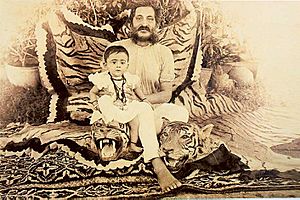
The 6th Nizam had a large family with seven sons and seven daughters. He married Amat Uz Zahra Begum, who was the daughter of Salar Jung I. They fell in love when he was 18 years old.
His Lifestyle
The Nizam was known for his grand lifestyle. He had a huge collection of clothes and cars. He even had a whole part of his palace just for his clothes! It was said he never wore the same outfit twice. He also owned the famous Jacob Diamond, which is one of the largest diamonds in the world. This diamond is now part of the Jewels of The Nizams owned by the Indian government.
Mahboob Ali Khan was very smart and could speak Urdu, Telugu, and Persian. He even wrote poems in Telugu and Urdu, and some of them are carved into the walls along the Tank Bund in Hyderabad. He was also a skilled hunter and was known for hunting tigers.
His Death
The 6th Nizam passed away on August 29, 1911, when he was 45 years old. He was buried next to his ancestors at the Mecca Masjid, Hyderabad. His second son, Mir Osman Ali Khan, became the next Nizam and was the last ruler of Hyderabad.
Mystical Powers
Mahboob Ali Khan believed he had a special power to heal people bitten by snakes. He even ordered that anyone who had a snakebite could come to him for help. Because of this, he was often woken up in the middle of the night to try and cure people.
Other Names
Mahboob Ali Pasha
People often called him "Mahboob Ali Pasha." "Mahboob" means "Dear one," showing how much people liked him.
Tees Maar Khan
He was also known as Tees Maar Khan. This nickname means "the Khan who killed thirty." He earned this name because he was a very good hunter. Villagers would often ask for his help to kill tigers that were a danger to their farms and lives. He ended up killing at least 33 tigers during his lifetime.
Even though he was a tiger hunter, he was also known for being kind and respectful to animals. He only hunted tigers when it was necessary to protect people. He understood that tigers were magnificent creatures that deserved to live unless they were a threat.
Honours
British Honours
- Empress of India Gold Medal, 1877
- Knight Grand Commander of the Order of the Star of India (GCSI), 1884
- Honorary Knight Grand Cross of the Order of the Bath (GCB), 1903
- Delhi Durbar Gold Medal, 1903
Foreign Honours
See also
- Hyderabad State
- Nizam
- Category:Establishments in Hyderabad State
- Jewels of the Nizams
- Nizam College


